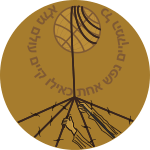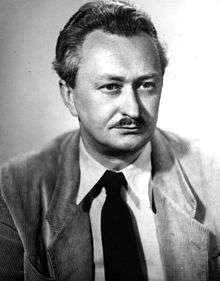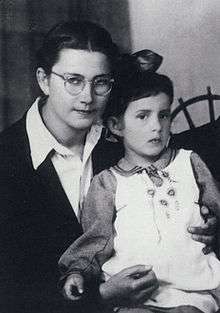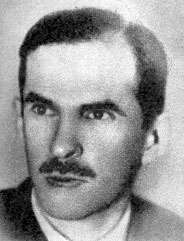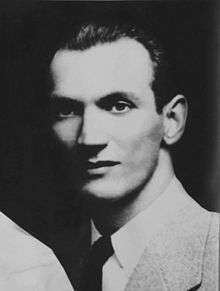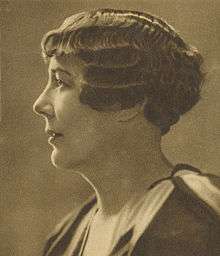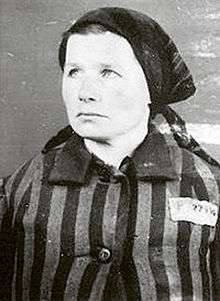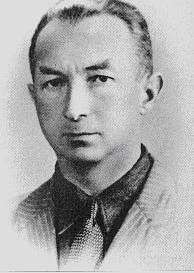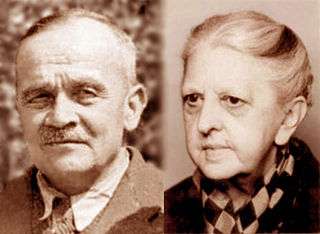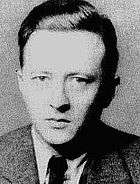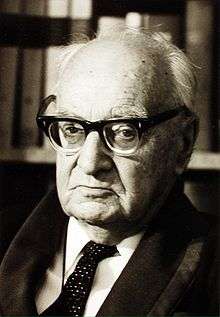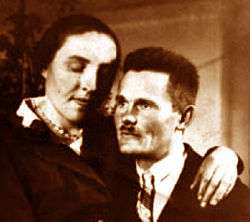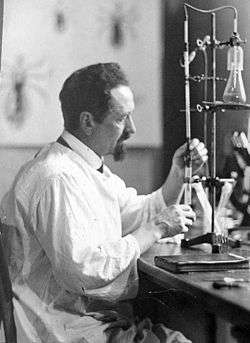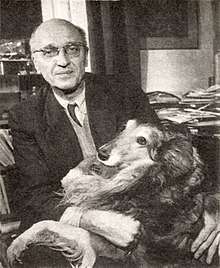Polish Righteous Among the Nations
| Medals and diplomas awarded at a ceremony in the Polish Senate on 17 April 2012 | |
|
There are 6,863 Polish men and women recognized as Righteous by the State of Israel |
The citizens of Poland have the world's highest count of individuals who have been recognized by Yad Vashem of Jerusalem as the Polish Righteous Among the Nations, for saving Jews from extermination during the Holocaust in World War II. As of 1 January 2018, there are 6,863 Polish men and women recognized as Righteous Among the Nations[1], over a quarter the of 26,973 recognized by Yad Vashem in total.[2]
It is estimated that hundreds of thousands of Poles concealed and aided hundreds of thousands of their Polish-Jewish neighbors.[3][4] Many of these initiatives were carried out by individuals, but there also existed organized networks of Polish resistance which were dedicated to aiding Jews – most notably, the Żegota organization.
In German-occupied Poland the task of rescuing Jews was especially difficult and dangerous compared to other European countries under German occupation. All household members were punished by death if a Jew was found concealed in their home or on their property.[5] It is estimated that the number of Poles who were killed by the Nazis for aiding Jews was as high as tens of thousands, 704 of whom were posthumously honored with medals.[3][6][7]
Activities
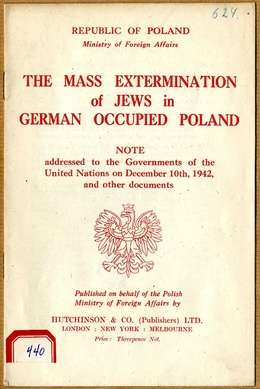
Before World War II, Poland's Jewish community had numbered between 3,300,000[8] and 3,500,000 people – about 10 percent of the country's total population. Following the invasion of Poland, Germany's Nazi regime sent millions of deportees from every European country to the concentration and forced-labor camps set up in the General Government territory of occupied Poland and across the Polish areas annexed by Nazi Germany.[9] Most Jews were imprisoned in the Nazi ghettos, which they were forbidden to leave. Soon after the German–Soviet war had broken out in 1941, the Germans began their extermination of Polish Jews on either side of the Curzon Line, parallel to the ethnic cleansing of the Polish population including Romani and other minorities of Poland.[9]
As it became apparent that, not only were conditions in the ghettos terrible (hunger, diseases, executions), but that the Jews were being singled out for extermination at the Nazi death camps, they increasingly tried to escape from the ghettos and hide in order to survive the war.[10] Many Polish Gentiles concealed hundreds of thousands of their Jewish neighbors. Many of these efforts arose spontaneously from individual initiatives, but there were also organized networks dedicated to aiding the Jews.[11]
Most notably, in September 1942 a Provisional Committee to Aid Jews (Tymczasowy Komitet Pomocy Żydom) was founded on the initiative of Polish novelist Zofia Kossak-Szczucka, of the famous artistic and literary Kossak family. This body soon became the Council for Aid to Jews (Rada Pomocy Żydom), known by the codename Żegota, with Julian Grobelny as its president and Irena Sendler as head of its children's section.[12][13]
It is not exactly known how many Jews were helped by Żegota, but at one point in 1943 it had 2,500 Jewish children under its care in Warsaw alone. At the end of the war, Sendler attempted to locate their parents but nearly all of them had died at Treblinka. It is estimated that about half of the Jews who survived the war (thus over 50,000) were aided in some shape or form by Żegota.[14]
In numerous instances, Jews were saved by the entire communities, with everyone engaged,[15] such as in the villages of Markowa[16] and Głuchów near Łańcut,[17] Główne, Ozorków, Borkowo near Sierpc, Dąbrowica near Ulanów, in Głupianka near Otwock,[18] Teresin near Chełm,[19] Rudka, Jedlanka, Makoszka, Tyśmienica, and Bójki in Parczew-Ostrów Lubelski area,[20] and Mętów, near Głusk. Numerous families who concealed their Jewish neighbours paid the ultimate price for doing so.[16] Several hundred Poles were massacred in Słonim for sheltering Jews who escaped from the Słonim Ghetto. In Huta Stara near Buczacz, all Polish Christians and the Jewish countrymen they protected were burned alive in a church.[21]
Risk
| Warning of death penalty for supporting Jews | |
|---|---|
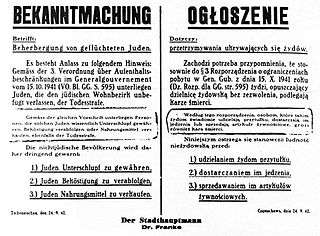 NOTICE
Concerning: According to this decree, those knowingly helping these Jews by providing shelter, supplying food, or selling them foodstuffs are also subject to the death penalty. This is a categorical warning to the non-Jewish population against: Dr. Franke |
During the occupation of Poland (1939–1945), the Nazi German administration created hundreds of ghettos surrounded by walls and barbed-wire fences in most metropolitan cities and towns, with gentile Poles on the 'Aryan side' and the Polish Jews crammed into a fraction of the city space. Anyone from the Aryan side caught assisting those on the Jewish side in obtaining food was subject to the death penalty.[22][23] The usual punishment for aiding Jews was death, applied to entire families.[5][24][25] On 10 November 1941, the death penalty was expanded by Hans Frank to apply to Poles who helped Jews "in any way: by taking them in for the night, giving them a lift in a vehicle of any kind" or "feed[ing] runaway Jews or sell[ing] them foodstuffs". The law was made public by posters distributed in all major cities. Polish rescuers were fully conscious of the dangers facing them and their families, not only from the invading Germans, but also from betrayers (see: szmalcowniks) within the local, multi-ethnic population and the Volksdeutsche.[26] The Nazis implemented a law forbidding all non-Jews from buying from Jewish shops under the maximum penalty of death.[27]
Gunnar S. Paulsson, in his work on history of the Jews of Warsaw, has demonstrated that, despite the much harsher conditions, Warsaw's Polish residents managed to support and conceal the same percentage of Jews as did the residents of cities in safer countries of Western Europe, where no death penalty for saving them ever existed.[28]
Over 700 Polish Righteous Among the Nations received their medals of honor posthumously, having been murdered by the Germans for aiding or sheltering their Jewish neighbors.[6] Current estimates of the number of Poles who were killed by the Nazis for aiding Jews range in the tens of thousands.[3][6]
Numbers
There are 6,863 officially recognized Polish Righteous – the highest count among nations of the world. At a 1979 international historical conference dedicated to Holocaust rescuers, J. Friedman said in reference to Poland: "If we knew the names of all the noble people who risked their lives to save the Jews, the area around Yad Vashem would be full of trees and would turn into a forest."[4]
Hans G. Furth holds that the number of Poles who helped Jews is greatly underestimated and there might have been as many as 1,200,000 Polish rescuers.[4] Władysław Bartoszewski, a wartime member of Żegota, estimates that "at least several hundred thousand Poles... participated in various ways and forms in the rescue action."[3] Recent research supports estimates that about a million Poles were involved in such rescue efforts,[3] "but some estimates go as high as 3 million."[3]
Gunnar S. Paulsson wrote: "How many people in Poland rescued Jews? Of those that meet Yad Vashem's criteria – perhaps 100,000. Of those that offered minor forms of help – perhaps two or three times as many. Of those who were passively protective – undoubtedly the majority of the population". [29]
Father John T. Pawlikowski (a Servite priest from Chicago)[30] remarked that the hundreds of thousands of rescuers strike him as inflated.[31]
Notable rescuers
|
|
See also
- Stanisława Leszczyńska: a Polish midwife at the Auschwitz concentration camp
- History of the Jews in 20th-century Poland
- Holocaust in Poland
- "Polish death camp" controversy
Notes
- ↑ "Righteous Among the Nations Honored by Yad Vashem" (PDF).
- ↑ "Names of Righteous by Country | www.yadvashem.org". www.yadvashem.org. Retrieved 2018-09-29.
- 1 2 3 4 5 6 Richard C. Lukas, Out of the Inferno: Poles Remember the Holocaust University Press of Kentucky 1989 – 201 pages. Page 13; also in Richard C. Lukas, The Forgotten Holocaust: The Poles Under German Occupation, 1939–1944, University Press of Kentucky 1986 – 300 pages.
- 1 2 3 Furth, Hans G. (1999). "One million Polish rescuers of hunted Jews?". Journal of Genocide Research. 1 (2): 227–232. doi:10.1080/14623529908413952.
Thousands of helping acts were done on impulse, on the spur of the moment, lasting no longer than a few seconds to a few hours: such as a quick warning from mortal danger, giving some food or water, showing the way, sheltering from cold or exhaustion for a few hours. None of these acts can be recorded in full detail, with persons and names counted; yet without them the survival of thousands of Jews would not have been possible.[228] If these people are anywhere typical of non-Jews under the Nazis, the percentage of 20 percent [rescuers] represents a huge number of many millions. I was truly astonished when I read these numbers...[230]
- 1 2 “Righteous Among the Nations” by country at Jewish Virtual Library
- 1 2 3 The HolocaustForgotten.com, "Righteous of the World: Polish citizens killed while helping Jews During the Holocaust." By Chaim Chefer. Source: Those That Helped, 1996.
- ↑ Gunnar S. Paulsson. Secret City. The Hidden Jews of Warsaw, 1940–1945. Yale University Press, 2002.
- ↑ London Nakl. Stowarzyszenia Prawników Polskich w Zjednoczonym Królestwie [1941] ,Polska w liczbach. Poland in numbers. Zebrali i opracowali Jan Jankowski i Antoni Serafinski. Przedmowa zaopatrzyl Stanislaw Szurlej.
- 1 2 Franciszek Piper. "The Number of Victims" in Gutman, Yisrael & Berenbaum, Michael. Anatomy of the Auschwitz Death Camp, Indiana University Press, 1994; this edition 1998, p. 62.
- ↑ Martin Gilbert. The Righteous: The Unsung Heroes of the Holocaust. Macmillan, 2003. pp 101.
- ↑ Tadeusz Piotrowski (1997). "Assistance to Jews". Poland's Holocaust. McFarland & Company. p. 117. ISBN 0-7864-0371-3.
- ↑ John T. Pawlikowski, Polish Catholics and the Jews during the Holocaust, in, Google Print, p. 113 in Joshua D. Zimmerman, Contested Memories: Poles and Jews During the Holocaust and Its Aftermath, Rutgers University Press, 2003, ISBN 0-8135-3158-6
- ↑ Andrzej Sławiński, Those who helped Polish Jews during WWII. Translated from Polish by Antoni Bohdanowicz. Article on the pages of the London Branch of the Polish Home Army Ex-Servicemen Association. Last accessed on 14 March 2008.
- ↑ Tadeusz Piotrowski (1997). "Assistance to Jews". Poland's Holocaust. McFarland & Company. p. 118. ISBN 0-7864-0371-3.
- ↑ Dariusz Libionka, "Polska ludność chrześcijańska wobec eksterminacji Żydów—dystrykt lubelski," in Dariusz Libionka, Akcja Reinhardt: Zagłada Żydów w Generalnym Gubernatorstwie (Warsaw: Instytut Pamięci Narodowej–Komisja Ścigania Zbrodni przeciwko Narodowi Polskiemu, 2004), p.325. (in Polish)
- 1 2 The Righteous and their world. Markowa through the lens of Józef Ulma, by Mateusz Szpytma, Institute of National Remembrance
- ↑ Instytut Pamięci Narodowej, Wystawa „Sprawiedliwi wśród Narodów Świata”– 15 czerwca 2004 r., Rzeszów. "Polacy pomagali Żydom podczas wojny, choć groziła za to kara śmierci – o tym wie większość z nas." (Exhibition "Righteous among the Nations." Rzeszów, 15 June 2004. Subtitled: "The Poles were helping Jews during the war – most of us already know that.") Last actualization 8 November 2008. (in Polish)
- ↑ Jolanta Chodorska, ed., "Godni synowie naszej Ojczyzny: Świadectwa," Warsaw, Wydawnictwo Sióstr Loretanek, 2002, Part Two, pp.161–62. ISBN 83-7257-103-1 (in Polish)
- ↑ Kalmen Wawryk, To Sobibor and Back: An Eyewitness Account (Montreal: The Concordia University Chair in Canadian Jewish Studies, and The Montreal Institute for Genocide and Human Rights Studies, 1999), pp.66–68, 71.
- ↑ Bartoszewski and Lewinówna, Ten jest z ojczyzny mojej, Kraków: Wydawnictwo Znak, 1969, pp.533–34.
- ↑ Moroz and Datko, Męczennicy za wiarę 1939–1945, pp.385–86 and 390–91. Stanisław Łukomski, “Wspomnienia,” in Rozporządzenia urzędowe Łomżyńskiej Kurii Diecezjalnej, no. 5–7 (May–July) 1974: p.62; Witold Jemielity, “Martyrologium księży diecezji łomżyńskiej 1939–1945,” in Rozporządzenia urzędowe Łomżyńskiej Kurii Diecezjalnej, no. 8–9 (August–September) 1974: p.55; Jan Żaryn, “Przez pomyłkę: Ziemia łomżyńska w latach 1939–1945.” Conversation with Rev. Kazimierz Łupiński from Szumowo parish, Biuletyn Instytutu Pamięci Narodowej, no. 8–9 (September–October 2002): pp.112–17. In Mark Paul, Wartime Rescue of Jews. Page 252.
- ↑ Donald L. Niewyk, Francis R. Nicosia, The Columbia Guide to the Holocaust, Columbia University Press, 2000, ISBN 0-231-11200-9, Google Print, p.114
- ↑ Antony Polonsky, 'My Brother's Keeper?': Recent Polish Debates on the Holocaust, Routledge, 1990, ISBN 0-415-04232-1, Google Print, p.149
- ↑ Holocaust Survivors and Remembrance Project: Poland
- ↑ Robert D. Cherry, Annamaria Orla-Bukowska, Rethinking Poles and Jews: Troubled Past, Brighter Future, Rowman & Littlefield, 2007, ISBN 0-7425-4666-7, Google Print, p.5
- ↑ Mordecai Paldiel, The Path of the Righteous: Gentile Rescuers of Jews, page 184. Published by KTAV Publishing House Inc.
- ↑ Iwo Pogonowski, Jews in Poland, Hippocrene, 1998. ISBN 0-7818-0604-6. Page 99.
- ↑ Unveiling the Secret City H-Net Review: John Radzilowski
- 1 2 Gunnar S. Paulsson, "The Rescue of Jews by Non-Jews in Nazi-Occupied Poland,” published in The Journal of Holocaust Education, volume 7, nos. 1 & 2 (summer/autumn 1998): pp.19–44. Reprinted in: "Collective Rescue Efforts of the Poles," p. 256. Quoted in:"Archived copy" (PDF). Archived from the original on 6 February 2008. Retrieved 23 May 2012. compiled by Mark Paul, with selected bibliography; the Polish Educational Foundation in North America, Toronto 2007
- ↑ Margaret Monahan Hogan, ed. (2011). "Remembering the Response of the Catholic Church" (PDF file, direct download 1.36 MB). History 1933 – 1948. What we choose to remember. University of Portland. pp. 85–97. Retrieved 21 June 2013.
- ↑ John T. Pawlikowski. Polish Catholics and the Jews during the Holocaust: Heroism, Timidity, and Collaboration. In: Joshua D. Zimmerman, Contested Memories: Poles and Jews During the Holocaust and Its Aftermath, Rutgers University Press, 2003.
- 1 2 3 Anna Poray, "Archived copy". Archived from the original on 1 March 2008. Retrieved 2 September 2012.
- ↑ W. Bartoszewski and Z. Lewinowna, Appeal by the Polish Underground Association For Aid to the Jews, Yad Vashem Remembrance Authority, 2004.
- ↑ Anna Poray, "Archived copy". Archived from the original on 6 February 2008. Retrieved 6 February 2008.
- ↑ Yad Vashem Remembrance Authority 2008, The Righteous: Anna Borkowska, Poland
- ↑ ""Saving Jews: Polish Righteous" (b-v): Banasiewicz family including Franciszek, Magdalena, Maria, Tadeusz and Jerzy". Web.archive.org. 6 February 2008. Archived from the original on 6 February 2008. Retrieved 27 December 2012.
- ↑ Anna Poray,"Archived copy". Archived from the original on 6 February 2008. Retrieved 6 February 2008.
- ↑ Kystyna Danko, Poland; International Raoul Wallenberg Foundation
- ↑ Anna Poray,"Archived copy". Archived from the original on 6 February 2008. Retrieved 15 June 2008.
- ↑ About Maria Fedecka at www.mariafedecka.republika.pl, 2005
- ↑ Anna Poray,"Archived copy". Archived from the original on 6 February 2008. Retrieved 10 June 2008. , 2004.
- ↑ Anna Poray,"Archived copy". Archived from the original on 6 February 2008. Retrieved 10 June 2008.
- ↑ Anna Poray,"Archived copy". Archived from the original on 6 February 2008. Retrieved 25 August 2008.
- ↑ The Righteous Among the Nations, Yad Vashem
- ↑ Mordecai Paldiel, "Churches and the Holocaust: unholy teaching, good samaritans, and reconciliation" p.209-210, KTAV Publishing House, Inc., 2006, ISBN 0-88125-908-X, ISBN 978-0-88125-908-7
- ↑ Cypora (Jablon) Zonszajn in Siedlce, Poland. United States Holocaust Memorial Museum.
- ↑ Sylwia Kesler, Halina and Julian Grobelny as Righteous Among the Nations
- ↑ Curtis M. Urness, Sr. & Terese Pencak Schwartz, Irene Gut Opdyke: She Hid Polish Jews Inside a German Officers' Villa, at Holocaust Forgotten.com
- ↑ Holocaust Memorial Center, 1988 – 2007, Opdyke, Irene; Righteous Gentile
- ↑ Anna Poray,"Archived copy". Archived from the original on 6 February 2008. Retrieved 16 June 2006. Armia Krajowa mayor.
- ↑ Stefan Jagodzinski at the www.jewishvirtuallibrary.org
- ↑ Anna Poray,"Archived copy". Archived from the original on 6 February 2008. Retrieved 6 June 2008.
- ↑ Poles Honoured by Israel, Warsaw Life news agency
- ↑ Anna Poray, "Archived copy". Archived from the original on 6 February 2008. Retrieved 19 March 2015.
- ↑ Anna Poray,"Archived copy". Archived from the original on 6 February 2008. Retrieved 19 March 2015.
- ↑ Michael T. Kaufman, Jan Karski warns the West about Holocaust, The New York Times, 15 July 2000
- ↑ Yad Vashem Remembrance Authority, The Tree in Honor of Zegota, 2008
- ↑ "Maria Kotarba at www.auschwitz.org.pl" (PDF). Auschwitz.org.pl. Retrieved 27 December 2012.
- ↑ Israel Ministry of Foreign Affairs, 2008, The Righteous Among the Nations, 28 June 2003
- ↑ Peggy Curran, "Pole to be honoured for sheltering Jews from Gestapo," Reprinted by the Canadian Foundation of Polish-Jewish Heritage, Montreal Chapter. Station Cote St.Luc, C. 284, Montreal QC, Canada H4V 2Y4. First published: Montreal Gazette, 5 August 2003, and: Montreal Gazette, 10 December 1994.
- ↑ "Jerzy Jan Lerski. From biography featured in ''Historical Dictionary of Poland, 966–1945''". Web.ku.edu. 27 December 2012.
- ↑ March of the Living International, The Warsaw Ghetto Archived 5 June 2011 at the Wayback Machine.
- ↑ Anna Poray,"Archived copy". Archived from the original on 6 February 2008. Retrieved 2 September 2012.
- ↑ David M. Crowe, The Holocaust: Roots, History, and Aftermath. Published by Westview Press. Page 180.
- ↑ "Archived copy" (PDF). Archived from the original on 6 February 2008. Retrieved 23 May 2012. Polish Educational Foundation in North America, Toronto 2007. "Collective Rescue Efforts of the Poles", (pdf file: 1.44 MB).
- ↑ Stefania and her younger sister Helena Podgorska, United States Holocaust Memorial Museum, Washington, D.C., 2008
- ↑ Anna Poray,"Archived copy". Archived from the original on 6 February 2008. Retrieved 5 July 2008.
- ↑ www.mateusz.pl – interview with Konrad Rudnicki (Polish)
- ↑ Monika Scislowska, Associated Press, 12 May 2008, "Irena Sendler, Holocaust hero dies at 98". Retrieved 2 November 2012.
- ↑ Grzegorz Łubczyk, FKCh "ZNAK" 1999–2008, Henryk Slawik – Our Raoul Wallenberg Archived 27 September 2007 at the Wayback Machine., Trybuna 120 (3717), 24 May 2002, p. Aneks 204, p. A, F.
- ↑ Instytut Pamięci Narodowej, „Sprawiedliwi wśród Narodów Świata” – Warszawa, 7 stycznia 2004
- ↑ "Sunday – Catholic Magazine". Sunday.niedziela.pl. Retrieved 7 October 2011.
- ↑ FKCh "ZNAK" – 1999–2008,"Archived copy". Archived from the original on 25 March 2007. Retrieved 11 June 2008. 24 July 2003, from the Internet Archive
- ↑ Anna Poray,"Archived copy". Archived from the original on 6 February 2008. Retrieved 16 June 2006.
- ↑ Anna Poray,"Archived copy". Archived from the original on 6 February 2008. Retrieved 15 June 2008. . 2004
- ↑ Yad Vashem Remembrance Authority, 2008, Hiding in Zoo Cages; Jan & Antonina Zabinski, Poland
- ↑ Anna Poray,"Archived copy". Archived from the original on 6 February 2008. Retrieved 15 June 2008.
References
- Polish Righteous at the Museum of the History of Polish Jews
- Anna Poray, "Saving Jews: Polish Righteous. Those Who Risked Their Lives," at the Wayback Machine (archived 6 February 2008) with photographs and bibliography, 2004. List of Poles recognized as "Righteous among the Nations" by Israel's Yad Vashem (31 December 1999), with 5,400 awards including 704 of those who paid with their lives for saving Jews.
- Piotr Zychowicz, Do Izraela z bohaterami: Wystawa pod Tel Awiwem pokaże, jak Polacy ratowali Żydów, Rp.pl, 18 November 2009 (in Polish)
